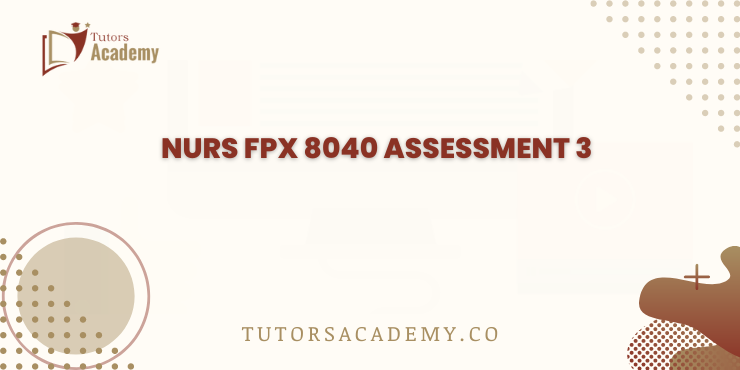
NURS FPX 8040 Assessment 3 Planned Intervention
Seeking guidance for your NURS FPX 8040 Assessment 3? Our team of experts is available to assist you. Contact us today for support.
The targeted intervention at ATLANTIC will involve significant changes to the medication ordering, reconciliation, and administration processes to decrease medication errors significantly. This strategy is designed to tackle the gap in doctor-ordered medications reported to occur for an average of 10 computer-mediated errors per month in 2023. Several fundamental shifts shall be brought into place in comparison to the current condition of operation (Halligan, 2023).
The educational intervention will also take the form of comprehensive training sessions for all healthcare providers involved in the medication management process. It will aim to build staff’s confidence and competence in procedures relating to entering, verifying, and administering medications, as well as maintaining proper documentation and communication skills. Medication order sets will also be incorporated within the EHR system to reduce variation, making ordering medication easier. A template of order sets will also be established for common medications that usually cause errors due to dosages or drug combinations (Sharifi et al., 2021).
Medication decision support components will be integrated into the EHR system to warn the healthcare providers about any potential adverse reaction to medications, possible dose changes, and drug interactions during the order entry process. This support layer will work as an additional layer to improve the accuracy and safety involved in the use of medications. Using the pharmacology checklist, the healthcare provider will apply the double-check verification policy for high-risk medications: The healthcare provider will double-check high-risk medications prepared for hospital patients because this has been flagged for double-check verification by pharmacy students (Alsaloom et al., 2022).
The effective development and adoption of these changes will require the involvement of different healthcare system professionals, including pharmacists, physicians, nurses, nurse practitioners, physician assistants, quality improvement specialists and informatics team members. Education: This will be carried out through dedicated workshop rooms as part of regular staff meetings and the use of the medical centre with available resources such as audio-visual equipment and simulation technology (Alsaloom et al., 2022).
Ethical Leadership
The project’s potential impacts specified in the Project Charter must be identified – on its benefactors and those affected by the project. Al-Worafi (2020) demonstrates that reducing medication can improve patient safety and benefit patients. Through the new processes, there will be less work to be done, which will also help boost the job satisfaction of healthcare providers. Nevertheless, it should be noted that some categories of patients, for instance, have limited awareness of health and patients who also belong to socially disadvantaged groups are more susceptible to such medication errors (Al-Worafi, 2020).
Transparency and inclusivity are two of the primary vital areas that should be adhered to in ethical leadership. These people must be considered essential in the project and involved in discussions and decision-making processes, such as with frontline healthcare providers and patients. The project sources must also be monitored from the perspective of vulnerable populations in vulnerable locations to ensure their needs and voices are heard throughout the project (Mulvale & Robert, 2021).
A specific power component is equity and the leadership style or strategy that the team leader, the Director of Patient Safety, can use to facilitate the process. According to Mulvale and Robert (2021), transformational leadership exemplified through inspiration and empowerment can encourage healthcare providers to take an active role in bringing the requisite changes to quality improvement. For example, servant leadership, which focuses on other people and their growth, promotes the culture of the organisation and the ability to cooperate and empathise (Mulvale & Robert, 2021).
Businesses could improve leaders’ efforts to handle equity and inclusivity by incorporating specialised skills and best practices, like improved communication, conflict & culture management, and cultural competency training (Leal & Houmanfar, 2021). At the same time, there should always be ways for the project’s proponents to see how things will help ensure the proper health of those undertaking the project. This may include offering physical and psychological resources, recognising problems and addressing them as they occur, and giving emotional support to help implementers as they face challenges with the program (Leal & Houmanfar, 2021).

SWOT Analysis
Strengths
In assessing the strengths of this project to reduce medication errors at AtlantiCare Regional Medical Center Mainland Campus, a list of solid attributes has shown some potential to aid in this process. The organisation has highly qualified healthcare providers who understand the healthcare system and bring something to implement effective interventions. There is also a positive environment to support quality improvement projects, which is maintained by leadership support and resources. The medical centre has all the requisites to prevent medication errors – effective technology, proper funding, and accountable quality improvement staff members (Lippman et al., 2024).
Award: The ability to work with other departments is a strength that requires collaboration in the fields. This transformation brings about quality improvement and strengthens the engagement of healthcare organisations in establishing quality improvement standards and patient safety principles (Lippman et al., 2024). Suppose AtlantiCare Regional Medical Center uses the above strengths. In that case, it is easy to demonstrate that medication management is a task that can be considered challenging. Still, the hospital knows how to achieve its goal: In six months, medication errors should be reduced to 5 per month.
Weaknesses
Several factors can hamper the project’s success of AtlantiCare Regional Medical Center, Mainland Campus, in terms of anticipating potential obstacles or challenges, especially in the aspect of the project. One of the most significant challenges is healthcare providers’ resistance to change. Past studies have demonstrated that organisational habits and customs could hinder or make change almost impossible, especially when new processes and procedures interfere with the standard workflow. Moreover, a lack of or problems with electronic health record systems may pose a barrier to successfully implementing interventions to reduce medication errors. These barriers will likely arise during an initiative, and it is crucial to prepare for them and find solutions to their harmful effects (Lippman et al., 2024).
Time and cost resources may strain the project team and vice-versa, resulting in poor achievement of the set goals. Large class sizes or needing more funds might make implementing a comprehensive training program impossible, or even purchasing the required technological upgrade. Finally, in the case of competing initiatives within the organisation, the issues of medication errors may take a backseat as energy and resources, among other things, may be focused somewhere else to accomplish organisational goals (Lippman et al., 2024). This is important as these potential challenges can be anticipated, and procedures to overcome them can be developed to ensure that AtlantiCare Regional Medical Center runs smoothly in the completion of projects.
Opportunities
If an individual can foresee any challenges and/or risks that may affect the project’s success at AtlantiCare Regional Medical Center, Mainland Campus, they would discover several factors that would be a roadblock. Healthcare providers’ resistance to change because of a prevailing routine or habit is a significant barrier, especially when the new changes interfere with the established workflow. Lastly, the capability of the EHR system and other technological factors could also hinder the effective implementation of interventions needed to eliminate medication errors (Jung et al., 2021). Time scarcity and the availability of resources, such as adequate staff and/or finances, may also negatively impact training programmes and/or necessary technology change. Threats from external and internal factors, such as competing organisational priorities, may further create distractions and reduce the resources available to facilitate quality improvement activities. It is also worth preventing these problems so that the project will succeed and objectives will be fulfilled (Jung et al., 2021).
Threats
To apply the following strategies in the context of AtlantiCare Regional Medical Center, Mainland Campus, it is helpful to consider several potential external threats to the project’s success. Another external factor that could affect the medical centre is increasing competition from nearby medical facilities or treatment alternatives, which will reduce the number of patients and, therefore, the revenue the centre receives, which hinders it from devoting resources to improving its quality. In addition, changes in regulatory frameworks or new healthcare policies will create further risks. They may force project managers to alter their approaches and standards to deliver projects within planned timeframes. Political, economic and social factors include potential changes in reimbursement rates or monetary resources allocated to fund the project. AtlantiCare Regional Medical Center needs to understand the possible threats and be aware of any surrounding forces that may interfere with its project so it can change its strategy in time and prevent potential risks (Zhang et al., 2023).
Events or crises in the environment which provided for the project but are beyond the control of the management of the project, like a natural disaster or a public health emergency, may hinder the completion of the project on time and cause an interruption in what the management has planned. These factors can profoundly affect healthcare delivery and magnify existing problems healthcare systems encounter, such as resource inefficiency and low numbers of available workers. Further, technological failures or cyber-attacks expose data used for project assessment and mitigation to errors and risks of leaks. Practices of ‘unplanning’ like risk avoidance or risk transference should be avoided as ‘planning’ like upward contingency planning or disaster preparedness procedures are needed to reduce the negative impact of such threats and make the project more robust (Zhang et al., 2023). Suppose AtlantiCare Regional Medical Center considers these potential threats and applies the risk management system. In that case, it can be sure that it will not affect the quality improvement program’s continuity and success.
Click below to explore more related sample:
NURS FPX 8040 Assessment 2
References
Al-Worafi, Y. M. (2020). Medication errors. Drug Safety in Developing Countries, 59–71.
https://doi.org/10.1016/b978-0-12-819837-7.00006-6
Alsaloom, M. S. M., Alsaloom, H. A. H., Alsaloom, H. A. M., Humayyim, M. M. M. B., Lasloum, M. J. S., Lsloom, D. N. M., & Lasloum, A. R. A. M. (2022). Enhancing medication safety through the implementation of a double check system: Strategies, benefits, and challenges. Advances in Clinical and Experimental Medicine, 9(4).
https://journal.yemdd.org/index.php/acamj/article/view/247
Elshayib, M., & Pawola, L. (2020). Computerized provider order entry–related medication errors among hospitalized patients: An integrative review. Health Informatics Journal, 26(4), 146045822094175.
https://doi.org/10.1177/1460458220941750
Gillani, S. W., Gulam, S. M., Thomas, D., Gebreigziabher, F. B., Al-Salloum, J., Assadi, R. A., & Sam, K. G. (2020). Role and services of pharmacist in the prevention of medication errors: A systematic review. Current Drug Safety, 16(3).
https://doi.org/10.2174/1574886315666201002124713
Halligan, D. B. (2023, June 1). In the name of safety: identifying, understanding and stopping low-value safety practices. Etheses.whiterose.ac.uk.
https://etheses.whiterose.ac.uk/33131/
Jung, S. Y., Hwang, H., Lee, K., Lee, D., Yoo, S., Lim, K., Lee, H. Y., & Kim, E. (2021). User perspectives on barriers and facilitators to the implementation of electronic health records in behavioral hospitals: Qualitative study. JMIR Formative Research, 5(4).
Leal, E. J. L., & Houmanfar, R. A. (2021). Creating inclusive and equitable cultural practices by linking leadership to systemic change. Behavior Analysis in Practice, 14, 499–512.
https://doi.org/10.1007/s40617-020-00519-7
Lippman, D., Stump, M., Veazey, E., Guimarães, S. T., Rosenfeld, R., Kelly, J. H., Ornish, D., & Katz, D. L. (2024). Foundations of lifestyle medicine and its evolution. Mayo Clinic Proceedings: Innovations, Quality & Outcomes, 8(1), 97–111.
https://doi.org/10.1016/j.mayocpiqo.2023.11.004
Mulvale, G., & Robert, G. (2021). Special issue-engaging vulnerable populations in the co-production of public services. International Journal of Public Administration, 44(9), 711–714.
https://doi.org/10.1080/01900692.2021.1921941
Sharifi, M., Pooya, A. A. A., & Roknabadi, M. R. S. (2021). Burnout among healthcare providers of COVID-19; A systematic review of epidemiology and recommendations: Archives of Academic Emergency Medicine, 9(1), e7–e7.
https://doi.org/10.22037/aaem.v9i1.1004
Zhang, S., Zhang, F., Xue, B., Wang, D., & Liu, B. (2023). Unpacking resilience of project organizations: A capability-based conceptualization and measurement of project resilience. International Journal of Project Management, 41(8).
https://doi.org/10.1016/j.ijproman.2023.102541
Need help with your NURS FPX 8040 Assessment 3? Our experts are ready to assist you. Get in touch with us for support today.
